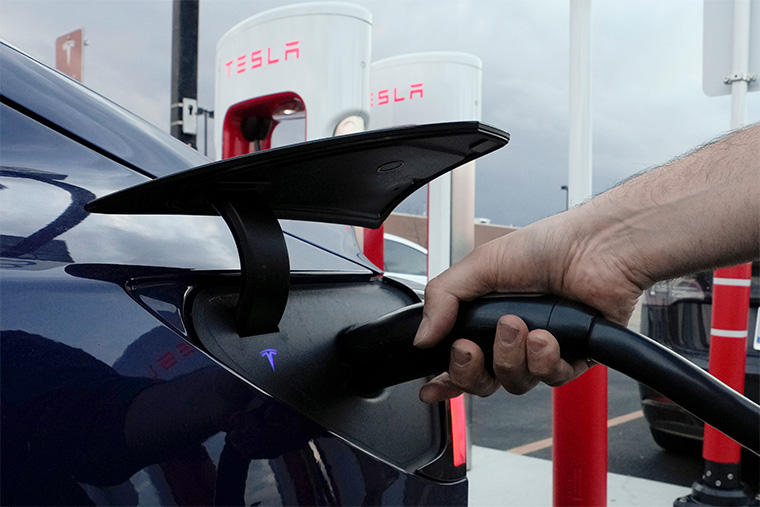By ALEXA ST. JOHN Associated Press
DETROIT (AP) — President Donald Trump’s tariff blitz has sent shock waves throughout every aspect of the global economy, including the auto sector, where multi-billion-dollar plans to electrify in the United States are especially at risk.
Here’s what consumers should know about the impact of tariffs on electric vehicles.
Where does EV adoption stand in the U.S.?
EVs accounted for about 8% of new car sales in the U.S. in 2024, according to Motorintelligence.com.
Some of those sales can be attributed to expanded tax credits for EV purchases, a Biden-era policy that spurred car buyer interest.
Tesla held a majority of U.S. EV market share in 2024, at 48%. But that share has declined in recent years, as brands including Ford (7.5%), Chevrolet (5.2%) and Hyundai (4.7%) began to offer a wider variety of electric models at better price points, according to Kelley Blue Book.
Electric vehicles remain more expensive than their gasoline-powered equivalents. New gas vehicles sold for $48,039 on average last month, Kelly Blue Book data says, while EVs sold for $55,273 on average.
Tariffs add on to the costs of an EV transition that was already volatile and uncertain, said Vanessa Miller, a litigation partner focused on automotive manufacturing at law firm Foley & Lardner.
What makes U.S. EV manufacturing so challenging?
Biden’s tax credits essentially required automakers to get more and more of their EV content from the U.S. or trade allies over the coming years in order for their vehicles to qualify. Automakers have worked to build an EV supply chain across the country and significant investment has gone toward these efforts.
EVs assembled here include Tesla models, the Ford F-150 Lightning and more. Tesla actually might be least vulnerable given how much of its vehicles come from the U.S.
Though the industry is growing, tariffs mean costs for automakers and their buyers will stay high and might go higher, as well as hike up the prices of the many parts of EVs still coming from China and elsewhere. From the critical minerals used in battery production to the vehicles themselves, China laps the U.S. industry.
Automakers were already pulling back on ambitious electrification plans amid shrinking federal support and are strapped for cash on what is the less lucrative side of their businesses.
What do the tariffs mean for EV pricing and inventory?
Higher prices might push car buyers to the used car market, but they aren’t likely to find much respite there.
If consumers don’t buy as many vehicles, automakers will have to prioritize their investments and manufacturing. That means the cars that buyers want and that are most profitable. Automakers still lose thousands of dollars on each EV they make and sell, but they make money from big, popular gas-guzzling pickup trucks and SUVs.
These manufacturers “have put a certain amount of investment into EVs, and it would probably be even more wasteful to completely walk away from them than it is to find the new level at which it makes sense to maintain production of them,” said Karl Brauer, executive analyst at auto research site iSeeCars.com. That level “will assuredly be lower than what it was,” he added.
Making fewer EVs won’t help bring their cost down further anytime soon.
Albert Gore, executive director of the Zero Emission Transportation Association, said in a statement the EV and battery sector is working to ensure that the American auto industry grows and that his group will work with the administration on productive trade policy.
“Tariffs on our longstanding trade partners, many of whom have committed billions in direct investment into U.S. factories, introduces uncertainty and risk into an industry that is creating jobs and bringing new economic opportunities to communities across the country,” Gore said.
How else have Trump’s policies stifled U.S. EV growth?
Trump has already taken a hatchet to federal EV policy. He campaigned on a vow to end what he called former President Joe Biden’s “EV mandate.”
Biden’s EV policies did not require automakers to sell EVs or consumers to buy them, but they did incentivize manufacturers to increase their electric offerings in the coming years. Trump put an end to Biden’s target for 50% of all new vehicles sold in the U.S. to be electric by 2035 in his first days in office.
Also under Biden, Environmental Protection Agency and National Highway Traffic Safety Administration rules on vehicle greenhouse gas emissions and fuel economy were to get increasingly tougher, but could be met by automakers selling a growing number of EVs alongside more fuel-efficient gasoline-powered vehicles. Trump’s administrators are already reevaluating emissions standards.
He’s also likely to seek to repeal the tax credits.
___
Alexa St. John is an Associated Press climate reporter. Follow her on X: @alexa_stjohn. Reach her at ast.john@ap.org.
___
The Associated Press’ climate and environmental coverage receives financial support from multiple private foundations. AP is solely responsible for all content. Find AP’s standards for working with philanthropies, a list of supporters and funded coverage areas at AP.org.






